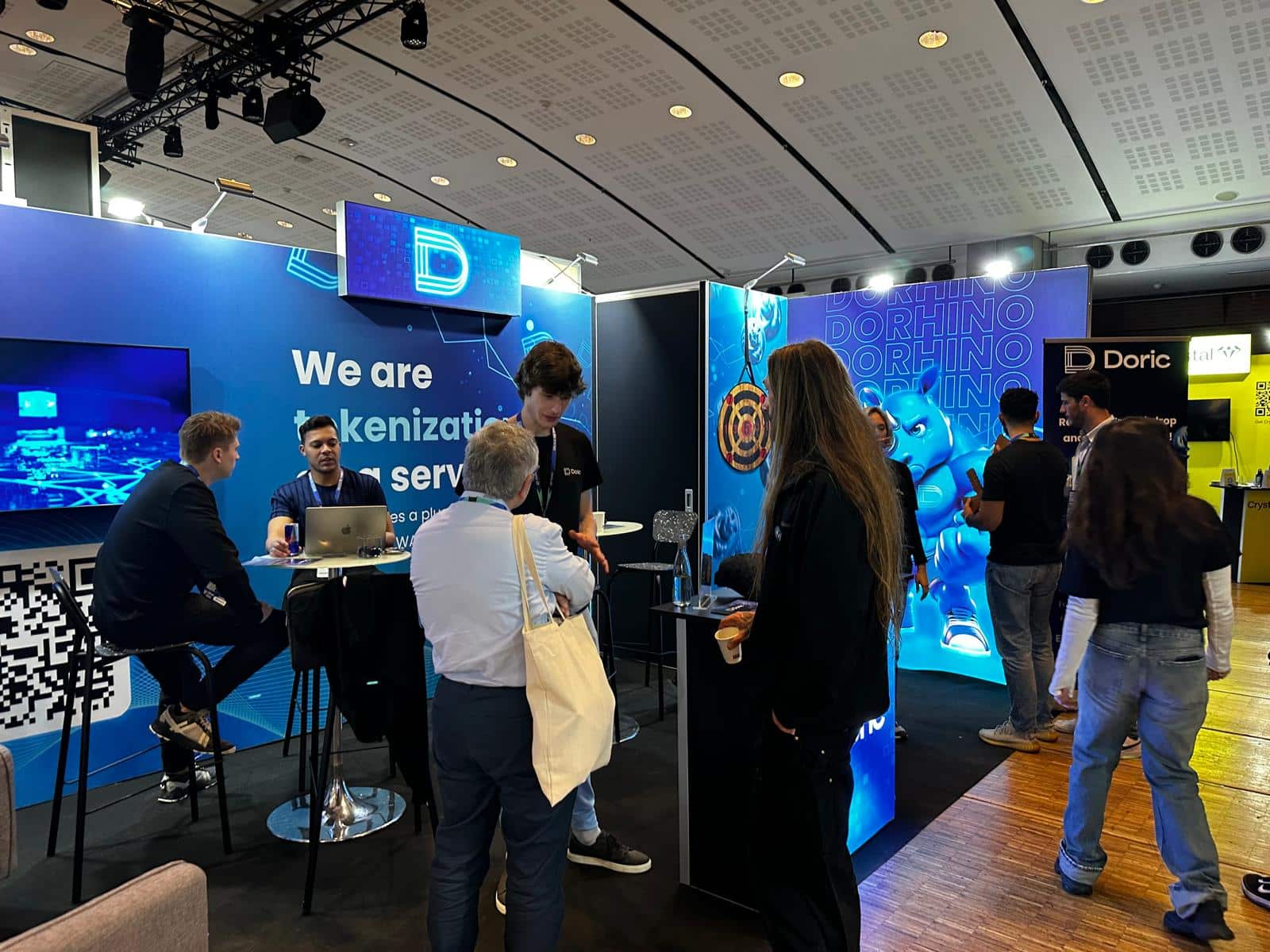DeFi
Paris Blockchain Week made the Louvre the Palace of Crypto and Web 3

The 5th edition of the largest crypto event in Europe – Paris Blockchain Week – recently concluded, marking a significant milestone in the blockchain and Web3 space. With over 9,000 attendees and 500 speakers, the event lived up to its reputation as a premier gathering of thought leaders, innovators and industry experts. The emblematic event took place the week of April 11 in one of the most prestigious venues in the world: the Carrousel du Louvre. The three-day insider event showcased the latest advancements and trends in blockchain technology, attracting a star-studded lineup of crypto leaders and sponsors.
Paris Blockchain Week featured a wide range of panels, discussions and presentations, covering topics such as Tech Builders, Public Policy and Corporate Web3. Notable speakers included Richard Teng (CEO of Binance), Denelle Dixon (CEO of Stellar Development Foundation), Tim Draper (high profile investor), and Marina Ferrari (French Secretary of State for Digital), among others.
1. Balancing decentralization and centralization in crypto
The balance between decentralization and centralization has become a focal point in the crypto industry. Although decentralization is a fundamental principle that drives innovation and adoption, its implications are now being examined in light of regulatory challenges and institutional requirements.
Decentralization, with its emphasis on privacy and self-custody, has been instrumental in popularizing concepts such as decentralized finance (DeFi) and improving user control over assets. However, the same features that attract users also raise concerns among regulators about illicit activities such as money laundering and terrorist financing.
This dichotomy has led to a cautious approach from institutional investors and businesses. They seek platforms that offer regulatory compliance and data control, often favoring private blockchains over public blockchains. Antoni Zolciak’s exploration of the relationship between public chains and corporations highlights the industry’s search for solutions that meet both decentralization advocates and institutional demands.
The prominent Dex 1Inch was one of the high-profile sponsors present at Paris Blockchain Week. 1inch stands out as a DEX aggregator, analyzing multiple decentralized exchanges to offer users the best prices and lowest fees. Using an algorithm and smart contracts, 1inch ensures that users always get the cheapest fees and best prices for their crypto. In addition to offering a wide range of ERC-20 tokens, 1inch allows users to make debit/credit card purchases through Moonpay. Users can also earn rewards by placing tokens in the platform’s liquidity pools, making 1inch an attractive option for those looking for additional income opportunities.
2. The impact of emerging Bitcoin ETFs and Altcoin ETFs
The approval of a spot Bitcoin exchange-traded fund (ETF) marked a significant milestone, signaling mainstream acceptance and attracting large inflows of capital into the crypto market. This development not only provided investors with a regulated pathway for exposure to Bitcoin, but also opened the way for discussions about possible ETFs for other cryptocurrencies.

Tim Draper’s optimistic outlook for Bitcoin’s price trajectory following ETF approval reflects growing confidence in digital assets as legitimate investment vehicles. Additionally, discussions around potential exchange-traded funds (ETFs) for altcoins like XRP and Ether indicate a broader trend toward diversification and institutional participation in the crypto space.
The potential of exchange-traded funds (ETFs) for cryptocurrencies like XRP and Ether reflects a positive trajectory toward mainstream acceptance and regulatory maturity in the crypto market.
Recent developments in the legal status of XRP provide greater regulatory clarity, paving the way for possible approval of ETFs. Strong market demand for exposure to XRP from institutional and retail investors makes the case for an XRP ETF, and growing institutional interest in diversified crypto portfolios creates a favorable environment for an XRP ETF.


Ethereum’s central role in DeFi and smart contracts makes Ether a very attractive asset for investors. As institutional interest grows, Ethereum and its technological advancements increase the potential for an Ether ETF. Additionally, the relatively clear regulatory status of Ethereum compared to other cryptocurrencies speaks in favor of an Ether ETF. The success of existing crypto ETFs and the evolving regulatory landscape create a positive environment for discussions around an Ether ETF.
3. Clarity of regulation and its influence on the evolution of cryptography
Regulatory clarity plays a crucial role in shaping the trajectory of the crypto industry. While some view regulation as a barrier to innovation, others argue that clear guidelines are essential for broader adoption and broader institutional participation.
The emergence of unified regulatory frameworks, such as the European Markets in Crypto Assets (MiCA) laws, demonstrates a maturing regulatory environment that aims to balance innovation and investor protection. These regulations provide a roadmap for businesses to meet compliance requirements and foster trust among market participants.
Verena Ross’s caution regarding the assumption of regulatory havens highlights the need for continued adaptation and compliance with ever-changing regulatory standards. As the regulatory landscape evolves, market participants must stay informed and proactively address compliance challenges.
- Adoption catalysts: tokenization and real-world assets:
Tokenization represents a transformative trend with implications beyond financial markets. By digitizing real-world assets, blockchain technology provides greater liquidity, accessibility and efficiency in asset management.
Larry Fink’s endorsement of asset tokenization as the next frontier in traditional finance highlights its potential to revolutionize the way assets are traded and managed. The benefits in terms of cost savings and increased market accessibility make tokenization an attractive proposition for both traditional financial institutions and emerging blockchain startups.
Tokenization’s diverse applications, from energy assets like solar to fractional ownership of heritage properties, demonstrate its versatility and potential to disrupt diverse industries beyond finance.


Among the high-caliber sponsors present at Paris Blockchain Week, The Doric Network impressed with its bold statement to become a plug-and-play solution for RWA owners who want a fast, reliable and one-stop solution for their businesses. The Layer 1, EVM-enabled blockchain aims to serve the market and demand coming from outside the crypto ecosystem because, according to Theodore Esery (Head of Global Development), there are “multiple owners of real-world assets who wish to tokenize their assets. but we don’t have the time or the expertise to do it, it’s a real demand that we have.”
- To change the mentalities
The shift from tribalism and maximalism to collaboration and inclusiveness reflects the maturation of the industry and the recognition of the need for diverse perspectives and expertise.
Ripple CEO Brad Garlinghouse’s focus on attracting developers from outside the crypto space underscores the industry’s ambition to expand its talent pool and drive innovation. By fostering a culture of collaboration and knowledge sharing, the crypto community can leverage collective expertise to tackle complex challenges and generate meaningful progress.
This change in mindset also encourages interoperability and integration between different blockchain platforms, thus fostering a more cohesive and interconnected ecosystem. As the industry continues to evolve, a collaborative approach will be essential to unlocking the full potential of blockchain technology and Web3 applications.
Lake.io is a pretty interesting use of blockchain technology and Web3 applications on display at PBW. After its successful appearance at the WOW Summit in Hong Kong, a pioneering Web3 ecosystem dedicated to transforming the global water economy, captivated attendees at Paris Blockchain Week 2024. As a testament to its burgeoning influence in the blockchain sectors, blockchain and sustainable development, Lake participated as a sponsor but also provided participants with water directly from Sembrancher, showcasing its innovative “spring to consumer” approach. , LAKE’s communications director, delivered a keynote address on the main stage, highlighting how LAKE is using blockchain technology to address the pressing challenges of water scarcity and accessibility.
Ultimately, Paris Blockchain Week proved to be another optimistic gathering of like-minded entrepreneurs and professionals, highlighting the challenges, opportunities and triumphs of our industry. To close this intense and exclusive week, leading investors and sponsors were treated to a private dinner and a tour of the famous Louvre Museum.


✓ Share:
Disclaimer This article is a paid publication and has no journalistic/editorial involvement of CoinGape. CoinGape does not endorse/subscribe to the content of the article/advertisement and/or opinions expressed herein. Do your market research before taking any action. The author or publication assumes no responsibility for your personal financial loss.
DeFi
Haust Network Partners with Gateway to Connect to AggLayer

Dubai, United Arab Emirates, August 1, 2024, Chainwire
Consumer adoption of cryptocurrencies is a snowball that is accelerating by the day. More and more people around the world are clamoring for access to DeFi. However, the user interface and user experience of cryptocurrencies still lag behind their fundamental utility, and users lack the simple and secure access they need to truly on-chain products.
Haust Network is a network and suite of products focused on changing this paradigm and bringing DeFi to the masses. To achieve this goal, Haust Network has announced its far-reaching partnership with bridgeseasoned veterans in rapidly delivering revolutionary blockchain utilities for projects. The Gateway team empowers blockchain developers to build DAOs, NFT platforms, payment services, and more. They drive adoption of crypto primitives for individuals and institutions around the world by helping everyone build their on-chain presence.
Gateway specializes in connecting sovereign blockchains to the Aggregation Layer (AggLayer). The AggLayer is a single unified contract that powers the Ethereum bridge of many disparate blockchains, allowing them all to connect to a single unified liquidity pool. The AggLayer abstracts away the complexities of cross-chain DeFi, making tedious multi-chain transactions as easy for the end user as a single click. It’s all about creating access to DeFi, and with Polygon’s technology and the help of Gateways, Haust is doing just that.
As part of their partnership, Gateway will build an advanced zkEVM blockchain for Haust Network, leveraging its extensive experience to deploy ultra-fast sovereign applications with unmatched security, and enabling Haust Network to deliver its products to its audience.
The recently announced launch of the Haust Wallet is a Telegram mini-app that provides users with access to DeFi directly through the Telegram interface. Users who deposit funds into the wallet will have access to all standard send/receive services and generate an automatic yield on their funds. The yield is generated by Haust Network’s interconnected network of smart contracts, Haustoria, which provides automated and passive DeFi yielding.
As part of this partnership, the Haust Network development team will work closely with Gateway developers to launch Haust Network. Gateway is an implementation provider for Polygon CDK and zkEVM technology, which the Haust wallet will leverage to deliver advanced DeFi tools directly to the wallet users’ fingertips. Haust’s partnership with Gateway comes shortly after the announcement of a high-profile alliance with the Polygon community. Together, the three will work to build Haust Network and connect its products to the AggLayer.
About Haust Network
Haust Network is an application-based absolute liquidity network and will be built to be compatible with the Ethereum Virtual Machine (EVM). Haust aims to provide native yield to all users’ assets. In Telegram’s Haust Wallet, users can spend and collect their cryptocurrencies in one easy place, at the same time. Haust operates its network of self-balancing smart contracts that interact across multiple blockchains and then efficiently funnel what has been generated to Haust users.
About Gateway
bridge is a leading white-label blockchain provider that offers no-code protocol deployment. Users can launch custom blockchains in just ten minutes. They are an implementation provider for Polygon CDK and have already helped projects like Wirex, Gnosis Pay, and PalmNFT bring new utility to the crypto landscape.
About Polygon Labs
Polygon Laboratories Polygon Labs is a software development company building and developing a network of aggregated blockchains via the AggLayer, secured by Ethereum. As a public infrastructure, the AggLayer will aggregate the user bases and liquidity of any connected chain, and leverage Ethereum as the settlement layer. Polygon Labs has also contributed to the core development of several widely adopted scaling protocols and tools for launching blockchains, including Polygon PoS, Polygon zkEVM, and Polygon Miden, which is currently under development, as well as the Polygon CDK.
Contact
Lana Kovalski
haustnetwork@gmail.com
DeFi
Ethena downplays danger of letting traders use USDe to back risky bets – DL News

- Ethena and ByBit will allow derivatives traders to use USDe as collateral.
- There is a risk in letting traders use an asset partially backed by derivatives to place more bets.
Ethena has downplayed the dangers of a new feature, which will allow traders to put up its synthetic dollar USDe as collateral when trading derivatives, which are risky bets on the prices of crypto assets.
While allowing users to underwrite their trades with yield-bearing USDe is an attractive prospect, Ethena said there is potential risk in letting traders use an asset partially backed by derivatives to place even more derivatives bets.
“We have taken this risk into account and that is why Ethena operates across more than five different sites,” said Conor Ryder, head of research at Ethena Labs. DL News.
The move comes as competition in the stablecoin sector intensifies.
In recent weeks, PayPal grown up the amount of its stablecoin PYUSD in circulation 96%, while the MakerDAO cooperative plans a rebrandingaiming to increase the supply of its DAI stablecoin to 100 billion.
US dollar growth stagnates
It comes as Ethena has lost momentum after its blockbuster launch in December.
In early July, USDe reached a record level of 3.6 billion in circulation.
That figure has now fallen by 11% to around 3.2 billion.
Join the community to receive our latest stories and updates
New uses for USDe could boost demand for Ethena’s products.
This is where the new plan, announcement Tuesday with ByBit, one of its partner exchanges, is coming.
Ethena users create USDe by depositing Bitcoin or Ether into the protocol.
Ethena then covers these deposits with short positions – bearish bets – on the corresponding asset.
This creates a stable support for USDe, unaffected by price fluctuations in Bitcoin or Ether.
Mitigate risks
While using USDe as collateral for derivatives trading is proving popular, it is unclear what the effects will be if the cryptocurrency market experiences major fluctuations.
Using derivatives as collateral to place more bets has already had disastrous effects.
In June 2022, Lido’s liquid staking token stETH broke its peg to Ether following the fallout from the Terra collapse.
Many traders who used looping leverage to increase their stETH staking yields were liquidated, creating a cascade that caused the price of Ether to drop by more than 43%.
Ethena Labs founder Guy Young said: DL News His office and his partners have taken many precautions.
Ethena spreads bearish bets supporting the USDe across the five exchanges it partners with.
According to Ethena, 48% of short positions supporting USDe are on Binance, 23% on ByBit, 20% on OKX, 5% on Deribit, and 1% on Bitget. website.
In doing so, Ethena aims to minimize the impact of an unforeseen event on a stock market.
The same theory applies to the distribution of risks across different supporting assets.
Fifty percent of USDe is backed by Bitcoin, 30% by Ether, 11% by Ether liquid staking tokens, and 8% by Tether’s USDT stablecoin.
Previous reviews
Ethena has already been criticised regarding the risks associated with USDe.
Some have compared USDe to TerraUSD, an undercollateralized stablecoin that collapsed in 2022.
“It’s not a good design for long-term stability,” said Austin Campbell, an assistant professor at Columbia Business School. said as the USDe launch approaches.
Young replied to critics, saying the industry needs to be more diligent and careful when “marketing products to users who might not understand them as well as we do.”
Ethena has since added a disclaimer on its website stating that USDe is not the same as a fiat stablecoin like USDC or USDT.
“This means that the risks involved are inherently different,” the project says on its website.
Tim Craig is DL News DeFi correspondent based in Edinburgh. Feel free to share your tips with us at tim@dlnews.com.
DeFi
Cryptocurrency and defi firms lost $266 million to hackers in July

In July 2024, the cryptocurrency industry suffered a series of devastating attacks, resulting in losses amounting to approximately $266 million.
Blockchain Research Firm Peck Shield revealed in an X post On August 1, attacks on decentralized protocols in July reached $266 million, a 51% increase from $176 million reported in June.
The most significant breach last month involved WazirX, one of India’s largest cryptocurrency exchanges, which lost $230 million in what appears to be a highly sophisticated attack by North Korean hackers. The attack was a major blow to the stock market, leading to a break in withdrawals. Subsequently, WazirX launched a program in order to recover the funds.
Another notable incident involved Compound Finance, a decentralized lending protocol, which suffered a governance attack by a group known as the “Golden Boys,” who passed a proposal who allocated 499,000 COMP tokens – valued at $24 million – to a vault under their control.
The cross-chain liquidity aggregation protocol LI.FI also fell victim On July 16, a hack resulted in losses of $9.73 million. Additionally, Bittensor, a decentralized machine learning network, was one of the first protocols to suffer an exploit last month, loming $8 million on July 3 due to an attack targeting its staking mechanism.
Meanwhile, Rho Markets, a lending protocol, suffered a $7.6 million breach. However, in an interesting twist, the exploiters research to return the stolen funds, claiming the incident was not a hack.
July 31, reports The Terra blockchain protocol was also hacked, resulting in a loss of $6.8 million across multiple cryptocurrencies. As crypto.news reported, the attack exploited a reentrancy vulnerability that had been identified a few months ago.
Dough Finance, a liquidity protocol, lost $1.8 million in Ethereum (ETH) and USD Coin (USDC) to a flash loan attack on July 12. Similarly, Minterest, a lending and borrowing protocol, saw a loss of $1.4 million due to exchange rate manipulation in one of its markets.
Decentralized staking platform MonoSwap also reported a loss of $1.3 million following an attack that allowed the perpetrators to withdraw the liquidity staked on the protocol. Finally, Delta Prime, another decentralized finance platform, suffered a $1 million breach, although $900,000 of the stolen funds was later recovered.
DeFi
The Rise of Bitcoin DeFi: Then and Now

The convergence of Bitcoin’s robust security and Layer 2 scaling solutions has catalyzed the emergence of a vibrant DeFi ecosystem.
By expanding Bitcoin’s utility beyond simple peer-to-peer payments, these advancements have opened up a new frontier of financial possibilities, allowing users to participate in decentralized lending, trading, and other complex smart contract operations on Bitcoin.
Read on to learn about the rise of Bitcoin-based decentralized finance and how the space has expanded to accommodate a new generation of native assets and features.
Note: If you want to learn candlesticks and chart trading from scratch, this is the best book available on Amazon! Get the book now!
What is DeFi?
Decentralized finance (DeFi) represents a paradigm shift in financial services, offering internet-based financial products such as trading, lending, and borrowing through the use of decentralized public blockchains.
By implementing blockchains, smart contracts, and digital assets, DeFi protocols provide financial services through a decentralized ecosystem, where participants do not have to deal with intermediaries when transacting.
What is Bitcoin DeFi?
The inherent limitations of the Bitcoin mainchain in supporting the intricacies of decentralized finance have created the need to develop smart contract-based Layer 2 solutions.
Additionally, the advent of the Ordinals protocol in 2023, which facilitated the emergence of fungible token standards such as BRC-20 and Runes, catalyzed the growth of DeFi on the Bitcoin blockchain.
This expansion in protocol diversity has broadened the applications of the world’s leading cryptocurrency network beyond the core base-layer use cases around value preservation and transactional capabilities.
Therefore, Bitcoin DeFi has become a nascent sector within the digital asset market, after previously being a missing essential part of the Bitcoin ecosystem.
Bitcoin DeFi in its early days
Integrating decentralized finance (DeFi) concepts into the Bitcoin ecosystem has been a journey of innovation and perseverance. Early attempts to bridge the gap between Bitcoin’s fundamental simplicity and DeFi’s complexities have spawned pioneering projects that, while laying essential foundations, have also encountered significant obstacles.
Colored coins
Colored coins represented an early foray into tokenizing real-world assets on the Bitcoin blockchain. By leveraging the existing network to track ownership of assets ranging from stocks to real estate, this approach highlighted Bitcoin’s potential as a platform beyond digital currency. However, scalability and practical implementation challenges have limited its widespread adoption.
Counterpart
Building on the colored coins, Counterparty has become a platform for creating and trading digital assets, including non-fungible tokens (NFTs), on Bitcoin.
The introduction of popular projects like Rare Pepe NFTs has demonstrated the growing appeal of digital collectibles. However, constraints around user experience and network efficiency have hampered its full potential.
These early experiments, while not fully realizing their ambitions, served as valuable stepping stones, informing Bitcoin DeFi’s subsequent developments. Their challenges highlighted the need for more sophisticated infrastructure and protocols to harness the full potential of decentralized finance on the Bitcoin network.
Bitcoin DeFi Today
Today, building DeFi applications on Bitcoin is primarily done in the realm of Layer 2 (L2) networks. This architectural choice is motivated by the limitations of Bitcoin’s base layer in supporting complex programmable smart contracts.
Bitcoin’s original design prioritized security and decentralization over programmability, making it difficult to develop sophisticated DeFi protocols directly on its blockchain. However, the recent emergence of protocols like Ordinals, BRC-20, and Runes, while not DeFi in their own right, has sparked possibilities for future DeFi-like applications on the main chain.
In contrast, L2 solutions offer a scalable and programmable environment built on Bitcoin, enabling the creation of various DeFi products.
By expanding Bitcoin’s capabilities without compromising its core principles, L2s have become the preferred platform for developers looking to build DeFi applications that encompass trading, lending, staking, and more.
Leading L2 networks such as Lightning Network, Rootstock, Stacks, and Build on Bitcoin provide the infrastructure for these efforts. Some of these L2s have even introduced their own native tokens to the network, further expanding Bitcoin’s DeFi ecosystem.
Essentially, while Bitcoin’s core layer presents challenges for DeFi development, its security and decentralization have provided a foundational layer for the innovative L2 landscape to thrive.
Bitcoin Layer 2 offers a promising path to building a robust and thriving Bitcoin-based DeFi ecosystem that offers trading, staking, lending, and borrowing. All you need is a DeFi Wallet like Xverse to access the new world of decentralized financial services secured by Bitcoin.
Conclusion
The integration of DeFi principles into the Bitcoin ecosystem, primarily facilitated by Layer 2 solutions, marks a significant evolution in the digital asset landscape.
Building on the foundational work of pioneers like Colored Coins and Counterparty, the industry has evolved into more sophisticated platforms like Rootstock, Stacks, and Build on Bitcoin to create a thriving Bitcoin-powered DeFi ecosystem.
Advertisement
-

 News1 year ago
News1 year agoBitcoin soars above $63,000 as money flows into new US investment products
-

 DeFi1 year ago
DeFi1 year agoEthena downplays danger of letting traders use USDe to back risky bets – DL News
-

 News1 year ago
News1 year agoFRA Strengthens Cryptocurrency Practice with New Director Thomas Hyun
-

 DeFi1 year ago
DeFi1 year agoZodialtd.com to revolutionize derivatives trading with WEB3 technology
-

 Markets1 year ago
Markets1 year agoBitcoin Fails to Recover from Dovish FOMC Meeting: Why?
-

 DeFi1 year ago
DeFi1 year ago👀 Lido prepares its response to the recovery boom
-

 Markets1 year ago
Markets1 year agoWhale Investments in Bitcoin Reached $100 Billion in 2024, Fueling Crazy Investor Optimism ⋆ ZyCrypto
-

 Markets1 year ago
Markets1 year agoWhy Bitcoin’s price of $100,000 could be closer than ever ⋆ ZyCrypto
-

 DeFi1 year ago
DeFi1 year agoPancakeSwap integrates Zyfi for transparent, gas-free DeFi
-

 Markets1 year ago
Markets1 year agoWhales are targeting these altcoins to make major gains during the bull market 🐋💸
-

 News1 year ago
News1 year agoHow to make $1 million with crypto in just 1 year 💸📈
-

 DeFi1 year ago
DeFi1 year ago🏴☠️ Pump.Fun operated by Insider Exploit







